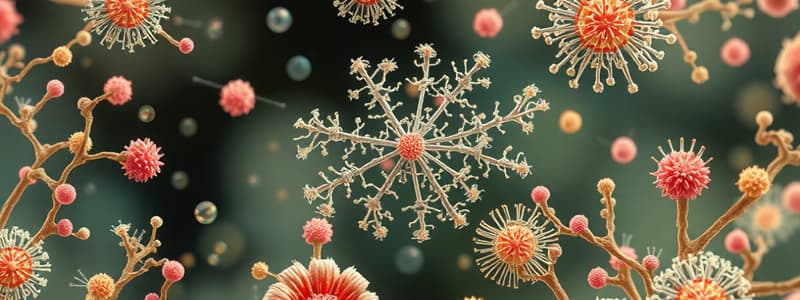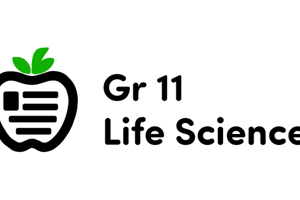Podcast
Questions and Answers
What is the central idea of the theory of spontaneous generation?
What is the central idea of the theory of spontaneous generation?
- Life originates from existing living organisms.
- Life is created solely through chemical processes.
- Life is a result of biological evolution.
- Life can arise from non-living materials. (correct)
Who was the first to refute the idea that maggots spontaneously generate from rotting meat?
Who was the first to refute the idea that maggots spontaneously generate from rotting meat?
- Francesco Redi (correct)
- Jan Baptista van Helmont
- Louis Pasteur
- Aristotle
What did Louis Pasteur demonstrate with his swan-neck flask experiments?
What did Louis Pasteur demonstrate with his swan-neck flask experiments?
- Bacteria can develop spontaneously.
- Pathogens can spontaneously generate under certain conditions.
- Life arises from chemical reactions.
- Microbial life can be eliminated through sterilization. (correct)
Which scientist is known as the 'Father of Microbiology and Immunology'?
Which scientist is known as the 'Father of Microbiology and Immunology'?
What was one of Louis Pasteur's major contributions to public health?
What was one of Louis Pasteur's major contributions to public health?
For how long did the theory of spontaneous generation persist?
For how long did the theory of spontaneous generation persist?
What conclusion did Aristotle reach about spontaneous generation?
What conclusion did Aristotle reach about spontaneous generation?
What process did Louis Pasteur develop to preserve food?
What process did Louis Pasteur develop to preserve food?
What does the term 'Microbiology' denote?
What does the term 'Microbiology' denote?
Which of the following is NOT considered a major group of microbes?
Which of the following is NOT considered a major group of microbes?
What is the significance of microorganisms in ecology?
What is the significance of microorganisms in ecology?
Who is known as the 'Father of Microbiology'?
Who is known as the 'Father of Microbiology'?
Which scientist is known for discovering penicillin?
Which scientist is known for discovering penicillin?
What did Louis Pasteur demonstrate through his experiments?
What did Louis Pasteur demonstrate through his experiments?
Which of the following terms refers to the study of interactions between microbes and their environment?
Which of the following terms refers to the study of interactions between microbes and their environment?
What landmark discovery did James Watson and Francis Crick make?
What landmark discovery did James Watson and Francis Crick make?
Which of the following is a characteristic of viruses?
Which of the following is a characteristic of viruses?
What method did Robert Koch develop that is vital in microbiology?
What method did Robert Koch develop that is vital in microbiology?
What mechanism helped prevent airborne microorganisms from entering the flasks?
What mechanism helped prevent airborne microorganisms from entering the flasks?
Which bacteria did Robert Koch identify as causative agents of disease?
Which bacteria did Robert Koch identify as causative agents of disease?
What significant contribution did Robert Koch make in 1881?
What significant contribution did Robert Koch make in 1881?
Which mold was responsible for the discovery of penicillin?
Which mold was responsible for the discovery of penicillin?
What was Alexander Fleming's role in the discovery of antibiotics?
What was Alexander Fleming's role in the discovery of antibiotics?
What characteristic was noted in Fleming's assay method regarding bacterial growth?
What characteristic was noted in Fleming's assay method regarding bacterial growth?
What year was the paper on the discovery of penicillin published by Alexander Fleming?
What year was the paper on the discovery of penicillin published by Alexander Fleming?
What type of microorganism is Penicillium?
What type of microorganism is Penicillium?
What is the primary focus of helminthology?
What is the primary focus of helminthology?
What is a defining characteristic of acellular microorganisms?
What is a defining characteristic of acellular microorganisms?
Which of the following statements about viruses is true?
Which of the following statements about viruses is true?
Which of the following is NOT a characteristic of prokaryotic cells?
Which of the following is NOT a characteristic of prokaryotic cells?
Which group of phytoplankton is known for causing red tides?
Which group of phytoplankton is known for causing red tides?
What unique feature does the Tobacco Mosaic Virus (TMV) have?
What unique feature does the Tobacco Mosaic Virus (TMV) have?
What is the primary focus of bacteriology?
What is the primary focus of bacteriology?
What method do bacteria use for reproduction?
What method do bacteria use for reproduction?
What type of organism is Sulfolobus acidocaldarius classified as?
What type of organism is Sulfolobus acidocaldarius classified as?
Which of the following is true about eukaryotic cells?
Which of the following is true about eukaryotic cells?
Which group of microorganisms is known for their role as natural decomposers?
Which group of microorganisms is known for their role as natural decomposers?
Which microorganism is associated with symbiotic relationships to obtain nutrients?
Which microorganism is associated with symbiotic relationships to obtain nutrients?
Which characteristic differentiates eukaryotes from prokaryotes?
Which characteristic differentiates eukaryotes from prokaryotes?
Flashcards are hidden until you start studying
Study Notes
Introduction To Microbiology
- Microbiology is the study of microscopic organisms, including bacteria, algae, protozoa, fungi, and viruses.
- Microbes are ubiquitous, meaning they are found everywhere in the world.
- Microorganisms are generally too small to be seen by the naked eye.
- Microorganisms are classified into cellular and acellular groups.
Types of Microorganisms
- Cellular: Prokaryotes are cells that do not have a nucleus or other membrane-bound organelles.
- Examples: Bacteria and Archaea
- Cellular: Eukaryotes are cells that have a nucleus and other membrane-bound organelles.
- Examples: Algae, Protozoa, and Fungi
- Acellular: Viruses are non-cellular, relying on living cells to replicate. They consist of a nucleic acid core surrounded by a protein coat.
Why is Microbiology Important?
- Microbiology helps us understand the fundamental processes of life.
- Microbiology plays a crucial role in many important scientific breakthroughs in medicine, agriculture, and industry.
Notable Milestones in Microbiology
- 1676: Antonie van Leeuwenhoek (father of microbiology & inventor of high-power microscopy) described bacteria & other microbes for the first time.
- 1799: Lazaro Spallanzani attempted to disprove the theory of "Spontaneous Generation".
- 1861: Louis Pasteur disproved "Spontaneous Generation" with his swan-neck flask experiment.
- 1866: Ernst Häeckel introduced the Kingdom Protista, "Ecology", and "Monera".
- 1883: Robert Koch developed techniques to isolate and culture bacteria.
- 1887: Sergei Winogradsky developed the concept of chemoautotrophy.
- 1905: Martinus Beijerinck discovered viruses (infectious agents) and described his work as "Microbial Ecology".
- 1929: Alexander Fleming discovered the antibiotic penicillin and the enzyme lysozyme.
- 1953: James Watson and Francis Crick solved the molecular structure of DNA.
- 1980: Carl Woese described Archaea and proposed the three domains of life.
- 1985: Kary Mullis invented the Polymerase Chain Reaction (PCR).
- 2004: Craig Venter used genome sequencing to examine the Sargasso Sea, identifying 1.2 million previously unknown genes.
Antonie Van Leeuwenhoek
- He crafted over 200 microscopes and was the first to see bacteria, which he called "wee animacules."
- He also described the green algae Chlamydomonas, Volvox, Spirogyra, Hematococcus, and the ciliate Vorticella for the first time.
Theory of Spontaneous Generation
- "Life from non-life" - the idea that living organisms arise from non-living materials.
- Aristotle believed that decaying material could be transformed into life.
- Jan Baptista van Helmont believed that mice could arise from rags and wheat kernels.
Louis Pasteur
- Disproved "Spontaneous Generation" and contributed to the germ theory of disease.
- Developed Pasteurization, a process that kills microbes in liquids.
- Developed treatment and prevention for rabies.
Robert Koch
- Discovered the causative agents of tuberculosis and cholera.
- Developed a method to isolate and culture microorganisms in a pure culture.
Alexander Fleming
- Discovered penicillin accidentally while working with bacteria.
- He observed that the growth of bacteria was inhibited in the presence of a mold (Penicillin).
Classification of Microorganisms
- Cellular - Prokaryotes
- Do not contain a nucleus or membrane-bound organelles
- Reproduce through binary fission.
- Cellular - Eukaryotes
- Have a true nucleus and membrane-bound organelles
- More complex than prokaryotes.
- Acellular - Viruses
- Neither prokaryotic nor eukaryotic
- Have no nucleus or membrane-bound organelles
- Can only replicate inside of a living cell
- Composed of few genes protected by a protein coat.
Divisions of Microbiology
- Bacteriology: Study of Bacteria
- Prokaryotic
- Do not contain a nucleus or other membrane-bound organelles
- Reproduction occurs through binary fission.
- Mycology: Study of Fungi
- Decomposers that secrete enzymes to break down food sources.
- Can form symbiotic relationships with plants and other organisms.
- Helminthology: Study of Parasitic Worms
- Large enough to be seen with the naked eye
- Cause a wide variety of infectious diseases
- Virology: Study of Viruses
- The smallest type of microbe
- Consist of DNA or RNA in their nucleic acid core
- Can only replicate inside of a living cell.
- Archaea: Study of ancient, single-celled microorganisms.
- Considered a separate domain of life.
Microbial Applications
- Microbes play important roles in human health, agriculture, and industry.
Studying That Suits You
Use AI to generate personalized quizzes and flashcards to suit your learning preferences.




